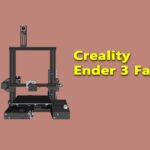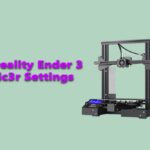What is PLA?
PLA is a biodegradable and environmentally friendly thermoplastic derived from renewable resources like corn starch, tapioca roots, and potato starch. PLA filament is available in a wide range of colors, including clear PLA.
Common problems of PLA in Creality Ender 3:
- Warping
- Stringing or “hairy” prints
- Difficult to remove from the build plate
- Clogged nozzle
Warping:
Warping is one of the most common problems associated with 3D printing. It occurs when the plastic shrinks as it cools, causing the edges of the print to curl up. Warping can be prevented by using a heated build plate and/or enclosing the printer.
Stringing or “hairy” prints:
Another common issue with PLA is stringing or “hairy” prints. This happens when small strings of plastic are left behind between the extruder and the print. Stringing can be prevented by increasing the retraction distance and/or decreasing the flow rate.

Difficult to remove from the build plate:
PLA can be difficult to remove from the build plate, especially if it is not properly cooled. The best way to avoid this problem is to use a blue painters tape or similar product.
Clogged nozzle:
One of the most frustrating problems associated with 3D printing is a clogged nozzle. This can happen for a variety of reasons, but it is usually caused by using too much filament or print too fast. The best way to prevent a clogged nozzle is to keep the filament dry and clean and to use a slow speed when printing.
Reason of PLA not sticking to bed:
PLA not sticking to the bed is a common problem, but there are a few things you can do to fix it. The first thing you need to do is make sure that your build plate is level. You can use a level or just eyeball it.
Solution of this problem:
If your build plate is level, the next thing you need to do is increase the temperature of your bed. The ideal temperature for PLA is around 60-70C. You can also try using a heated build plate or enclosing your printer.
Another solution is to use a different type of build surface. Blue painters tape and glass are both good options. You can also try using hairspray or ABS slurry.
If you are still having trouble, there are a few other things you can try. One is to increase the flow rate of your filament. Another is to reduce the width of your extrusion line. Finally, you can try changing the nozzle size.
Why is PLA difficult to remove from the build plate:
PLA can be difficult to remove from the build plate, especially if it is not properly cooled. The best way to avoid this problem is to use a blue painters tape or similar product. You can also try using a heated build plate or enclosing your printer.
What is the difference between PLA and ABS:
The main difference between PLA and ABS is that PLA is derived from renewable resources and is biodegradable, while ABS is derived from petroleum and is not biodegradable. PLA is also easier to print with and has a lower melting temperature, while ABS is more durable and has a higher melting temperature.
What is the best way to store PLA filament:
The best way to store PLA filament is in a cool, dry place. It is also important to keep the filament away from sunlight and other sources of heat.
If you are still having trouble, you can try increasing the flow rate of your filament or reducing the width of your extrusion line.
FAQ’s
1. What is PLA?
Ans: PLA is a biodegradable and environmentally friendly thermoplastic derived from renewable resources like corn starch, tapioca roots, and potato starch. PLA filament is available in a wide range of colors, including clear PLA.
2. What are common problems associated with PLA?
Ans: Some common problems associated with PLA are warping, stringing or “hairy” prints, difficult to remove from the build plate, and clogged nozzle.
3. Why does warping occur?
Ans: Warping occurs when the plastic shrinks as it cools, causing the edges of the print to curl up.
4. How can I prevent warping?
Ans: Warping can be prevented by using a heated build plate and/or enclosing the printer.
5. What is stringing or “hairy” prints?
Ans: Stringing or “hairy” prints occurs when small strings of plastic are left behind between the extruder and the print.
6. How can I prevent stringing?
Ans: Stringing can be prevented by increasing the retraction distance and/or decreasing the flow rate.
7. Why is PLA difficult to remove from the build plate?
Ans: PLA is difficult to remove from the build plate because it shrinks as it cools. The best way to avoid this problem is to use a blue painters tape or similar product.
8. Why does a clogged nozzle happen?
Ans: A clogged nozzle is usually caused by using too much filament or printing too fast. The best way to prevent a clogged nozzle is to keep the filament dry and clean and to use a slow speed when printing.
9. What can I do if my PLA doesn’t stick to the bed?
Ans: If your PLA doesn’t stick to the bed, you can try leveling the build plate, increasing the temperature of the bed, and/or using a different type of build surface. You can also try increasing the flow rate of your filament or reducing the width of your extrusion line.
10. What is the best way to store PLA filament?
Ans: The best way to store PLA filament is in a cool, dry place. You can also put the filament in an airtight container with a desiccant packet to keep it from getting wet.

